Use Extended Settings to customize device settings according to a list of rules. If a device meets a rule's conditions, then the settings for that rule are applied to the device. If a device does not meet any rules, or if you don't use this feature at all, then the default settings apply.
A device is evaluated against the rules in the order that the rules appear in the rule list. The first rule that a device meets is used to apply settings for that device. This means that it is important to set the order of the rule list. Note that a device is allowed to meet only one rule.
To access Extended Settings, go to Devices > Configuration > Settings > Agent > Extended Settings. Your account must have the permission Configure Extended Settings.
Devices might take up to an hour to update
After you update rules, it might take up to one hour for the updated rules to come into effect.
Note: Extended Settings override Custom Settings
Before this feature was available, ControlUp Support might have helped you apply custom settings to your tenant using JSON. Because some of these settings are now controlled using the Extended Settings UI, the following Custom Settings will be ignored after you create your first Extended Settings rule:
LocationsByIpRange
DoNotUseDeviceLocation
RebootNotification
DisableUCC
UserIdleTimeoutSecs
We recommend that you open your Custom Settings (Configuration > Settings > Custom Settings) to see if you are currently using any of the custom settings listed above. If any of them are used, you must recreate the setting using Extended Settings rules.
Add a new rule
To create a new rule:
Click Add Rule.
A new rule appears in the rule list without any conditions or settings. Read the sections below to learn how to define a rule's conditions and settings.
Define a rule's conditions
Create rule conditions with device tags using AND/OR logic. Learn how to add tags to a device.
To create conditions with AND statements, add multiple tags to the same line. In this case, a device must have all of the specified tags to meet the rule.
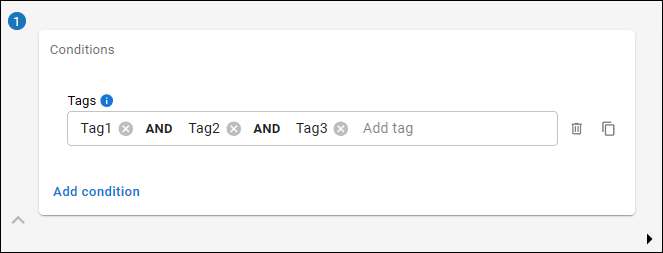
To create a condition using OR statements, click Add condition and add each tag in a separate field. In this case, a device must have one of the specified tags to meet the rule.
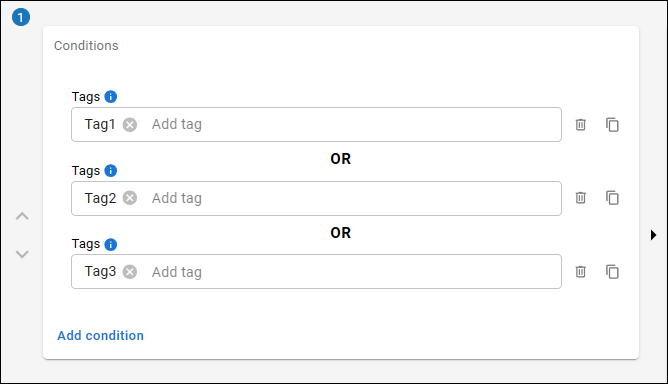
You can create conditions with a combination of AND and OR statements by using both of the methods described above.
Apply a rule to all devices
If you don't specify any conditions for a rule, then the rule will be met by all devices that don't meet a rule placed higher in the list. Note that any rule placed below a rule with no conditions will never be met. In most situations, a rule with no conditions should be the last rule in the list.
Define a rule's settings
You can configure the following settings for a rule. If you don't want to change a particular setting on a device, you can leave the setting empty or don't change its default.
Custom device location by IP range
Use this setting to override a device's location and place it at a custom location based on the device's internal IP address. Fill out the following fields to assign a custom location for devices within a specific range of IP addresses:
IP range - Enter the range of internal IP addresses in CIDR notation. For example, 192.0.2.0/24.
Location name - Enter a name for the custom location. The name you enter will appear in the Location column on the device details dashboard. Use this field to enter the names of cities, offices, sites, etc.
Latitude, Longitude - Enter the coordinates of the custom location.
True IP location is no longer recorded
If a device has it's location overridden by this setting, then the true location from the device's IP address is no longer recorded in ControlUp. The columns Public IP Country, Public IP State, and Public IP City in the Device details grid will be empty.
Add multiple rows to set the locations for more IP address ranges.
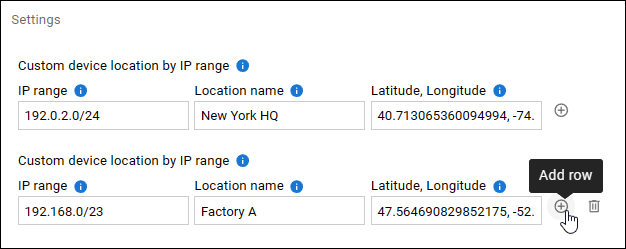
To set all devices to a custom location regardless of their IP addresses, set the IP range to 0.0.0.0/0. Read Completely hide device location below to learn how to hide all sources of location data.

Windows Agent uninstall password
By default, end users can uninstall the ControlUp for Desktops Agent from their Windows device. If you don't want to allow your end users to freely uninstall the Agent, use this setting to create a password.
If you set an uninstall password, then a user can uninstall the Agent only from the command line with the password entered in the parameter EDXPASSWORD. For example:
msiexec.exe /x {0EE8541E-2D9F-4382-820F-DE7B93F7ED53} /norestart /qn EDXPASSWORD=YourPasswordHere
System users are excluded from the password requirement.
Cache retention duration
By default, the ControlUp for Desktops Agent caches data on a device for up to 28 days while it isn't connected to your tenant. The Agent sends the cached data to your tenant when it reconnects. Use this setting to change the number of days that data is cached locally before it is deleted.
The amount of data that the Agent stores in the cache varies depending on activity and usage. Typically, this averages in the range of 10-20 MB per day.
Reboot notification text
Use this setting to customize the text in the notification Window when you perform a Reboot action on a device from ControlUp.
The text you enter appears in the following notification window.

Disable device location
Use this setting to disable geolocation reporting using Location Services on Windows and macOS devices. The location reported by Location Services can be very accurate. If you select this option, a device's location can be determined only by using the remote IP address. Read Completely hide device location below to learn how to hide all sources of location data.
If you select Disable Device Location, then the ControlUp for Desktops Agent on macOS devices will not prompt the device user for permission to access Location Services when the Agent is installed.
Disable UCC Agent data on the device
By default, UCC data is collected from the Microsoft Teams and Zoom APIs and the ControlUp for Desktops Agent installed on the device. Select this option to disable data collection from the Agent installed on the device. If you select this option, UCC data will still be collected using the Microsoft Teams and Zoom APIs.
The Agent is used to collect minute-by-minute metrics from Microsoft Teams and Zoom.
User idle timeout
Use this setting to change the time (in seconds) that a user has to be inactive before their activity status is Idle.
Changing this setting affects End User Activity data collection. After a user is Idle, then they are no longer considered to be actively using an application. This setting also affects user activity data in the Employees view because it is based on End User Activity data.
Process Monitoring Threshold % (CPU)
Sets the CPU usage threshold for a process to be named in the CPU Usage when viewing details for a device. These processes are in the _highresourceprocs data index.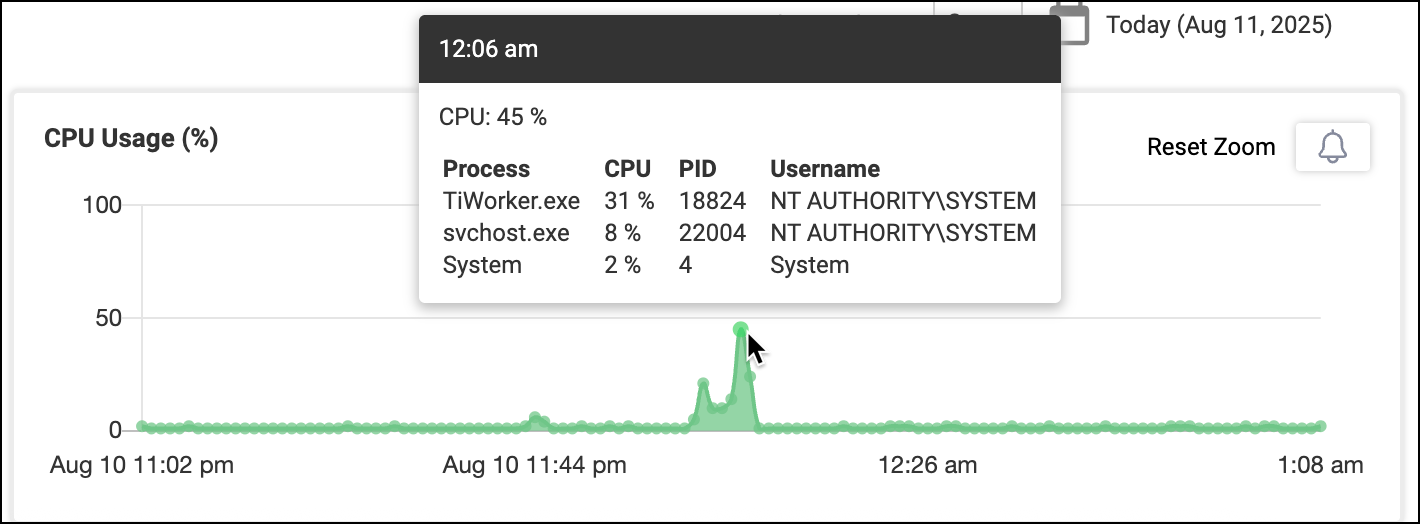
Process Monitoring Threshold % (Memory)
Sets the Memory usage threshold for a process to be named in the Memory Usage chart when viewing details for a device. These processes are in the _highresourceprocs data index.
CPU Idle Threshold
A device’s CPU is considered to be idle if it is below the set CPU usage percentage threshold. This affects the Run only when idle option for scripts. Read the Scripting Guide for details.
Mac only: Prevent network filter user prompt
By default, when you install the ControlUp for Desktops Agent onto a macOS device, the end user receives a prompt to allow the Agent to filter network traffic.
If you enable this option, the user does not receive the prompt. This means that data from the network filter (UC&C metrics and network bytes per process) won't be collected unless the network filter is enabled by some other method, such as an MDM solution.
Mac only: Prevent location user prompt
By default, when you install the ControlUp for Desktops Agent onto a macOS device, the end user receives a prompt to allow the Agent collect data from Location Services.
If you enable this option, the user does not receive the prompt. This means that geolocation data from Location Services won't be collected unless unless access to Location Services is enabled by some other method, such as an MDM solution. Geolocation data from the device's remote IP address will still be collected. Learn more about device geolocation.
Mac only: Prevent automation user prompt
By default, when you install the ControlUp for Desktops Agent onto a macOS device, the end user receives a prompt to allow the ControlUp Agent collect data from Location Services.
If you enable this option, the user does not receive the prompt. This means that geolocation data from Location Services won't be collected unless unless access to Location Services is enabled by some other method, such as an MDM solution. Geolocation data from the device's remote IP address will still be collected. Learn more about device geolocation.
Mac only: Prevent network filtering
By default, the macOS Agent uses a network filter to collect data from Microsoft Teams, and to collect network bytes used per process.
If you enable this option, the network filter won't collect any data.
Linux only: Enable floating remote control notification
By default, a notification in the system tray appears to let end users on Linux devices know that a Remote Control session is active.
If you enable this option, a floating ControlUp icon appears instead. This can be useful to ensure that the notification is visible even when the system tray is hidden. When a Remote Control session starts, full screen apps become windowed so that the floating Remote Control notification is visible.
Windows only: Enable native data collection
This option disables built-in script execution. The Agent will instead use native code to collect the same data. You should enable this option only under the guidance of ControlUp Support.
Change the rule order
Because a device is evaluated against the rules in the order that they appear in the rule list, you might want to change the rule order. To move rules in the list, click the up and down arrows.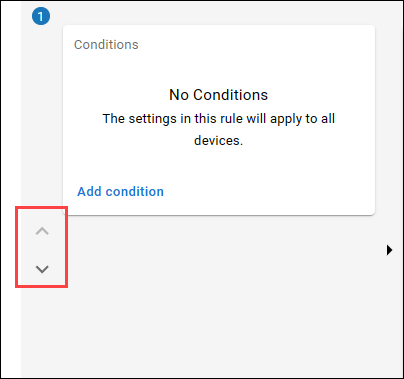
Duplicate a rule
To duplicate a rule, click Duplicate. The conditions and settings are copied to the new rule.
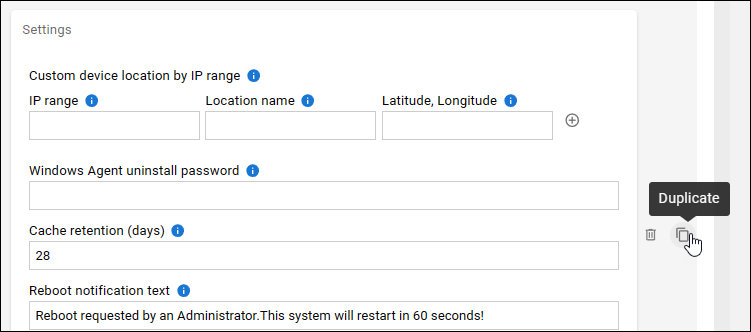
Completely hide device location
To completely hide a device's location data, you must hide the location data from the IP address and from Location Services. Learn more about how a device's location is determined.
Use Custom device location by IP range to set devices within an IP range to a location of your choosing. You can make this location data meaningless by setting the location to somewhere like the middle of the ocean. Note that you can apply the setting to all IP addresses by using the range 0.0.0.0/0.
Select Disable device location to disable location data from Location Services.
